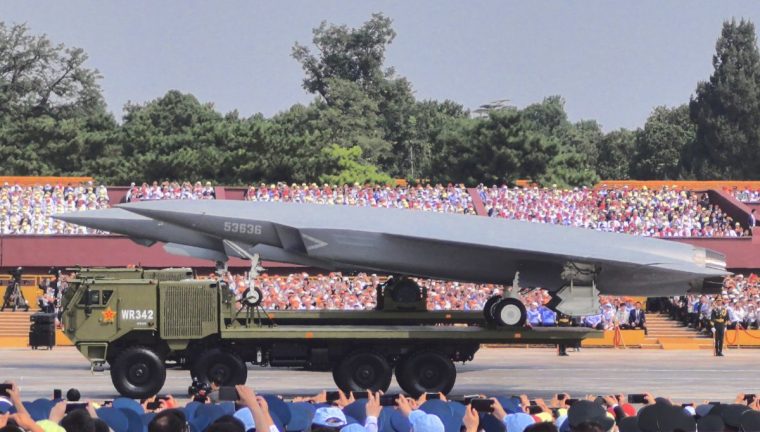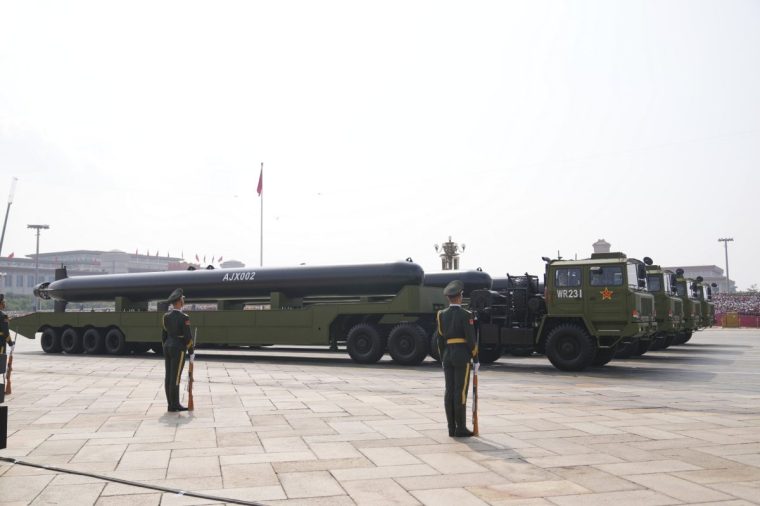Xi Jinping hailed China as an “unstoppable” force while the country’s military innovations rolled through Beijing
Xi Jinping declared China an “unstoppable” force as a procession of its latest tanks, missiles and drones rolled through central Beijing in the country’s largest ever military parade.
Laser weapons, nuclear ballistic missiles, and giant submarine drones were displayed at the parade on Wednesday, which celebrated the 80th anniversary of the end of the Second World War and China’s wartime victory over Japan.
The military arsenal was on full display for the more than 20 foreign leaders attending the parade – including North Korea’s Kim Jong-un and Russian President Vladimir Putin – as well as their potential adversaries, including the United States, its Nato allies, and Japan.

Military experts told The i Paper that although China displayed “important capabilities”, they would face “significant technical hurdles” before being deployed.
Addressing more than 50,000 spectators at the parade, China’s president – who also heads the military as the chairman of the Central Military Commission – told the crowd that China will “never be intimidated by any bullies” as he urged for the country to “speed up building” its “world-class military”.
“The great rejuvenation of the Chinese nation is unstoppable,” Xi added. “The noble cause of peace and development for mankind will surely triumph.”
The parade came after Xi hosted more than 20 world leaders, including Putin and Indian Prime Minister Narendra Modi, for the largest-ever summit of the Shanghai Co-operation Organization (SCO) in Tianjin earlier this week.
Addressing the summit – which aimed to challenge Western dominance on the world stage – Putin celebrated his country’s “unprecedented” relationship with China and said Nato expansion was the catalyst for Russia’s invasion of Ukraine.
Putin may be in a unique position to benefit from China’s military prowess, as Beijing is a key supplier for the Russian war machine, including drone capabilities.

Ahead of the parade, Donald Trump said on Truth Social: “Many Americans died in China’s quest for Victory and Glory. I hope that they are rightfully Honored and Remembered for their Bravery and Sacrifice!”
He added: “Please give my warmest regards to Vladimir Putin, and Kim Jong Un, as you conspire against The [sic] United States of America.”
Here, The i Paper takes a closer look at the arsenal unveiled during the parade, as well as whether it could be supplied to Russia and how it compares to Western countries’ weapons.
What weapons were unveiled?
Among new weapons unveiled at the parade was the LY-1 laser, which was mounted on top of an eight-wheeler HZ-155 armoured truck.
Christoph Bergs, research analyst for airpower at the Royal United Services Institute (Rusi), told The i Paper that such lasers “can defeat fast-flying cruise or anti-ship missiles”, damage sensors, and be used against humans, for example to dazzle pilots in aircraft.
He said: “The development of lasers, or directed energy weapons, is accelerating amongst many nations, including China.
“China appears keen to demonstrate its increasing technological capabilities with such systems. The recently unveiled LY-1 shipborne laser represents one example.”
Bergs added that such lasers are “incredibly precise, rapid-firing” and consume energy from a power supply – rather than ammunition – to strike targets.

“The effect against a target’s sensors or structure would be near-instantaneous compared to firing at the same target with traditional weapon systems. This makes them appealing, for example, to defeat fast-flying cruise or anti-ship missiles,” he said.
“Depending on the power output, lasers dazzle or damage sensors, or inflict structural damage. They can also be used against humans, for example to dazzle or injure pilots in aircraft.”
Turning to the disadvantages of the lasers, Bergs said they could require “very precise tracking sensors and data, which can be impaired by weather”.
He added: “Lasers can also only be used with direct line-of-sight to the target. This limits the engagement range and time against targets obscured by terrain or those flying at low altitude.”
Beyond the LY-1 laser, Beijing also unveiled the AJX002 uncrewed underwater vehicles – submarine drones up to 20 metres long.

These drones are believed to be capable of surveillance or gathering intelligence, as well as offensive missions such as laying mines.
The DF-5C, a new variant of China’s Dongfeng-5 nuclear intercontinental ballistic missile (ICBM), was also presented at the parade.
This ICBM is believed to have a longer range and can carry up to 12 warheads on a single missile. It is silo-based, meaning it is launched from a facility dug deep into the ground.
Could the weapons be supplied to Russia?
Bergs said that the LY-1 lasers would assist Russia in defending itself from Ukrainian drone strikes as well as augment existing electronic warfare and surface-to-air weapons. But he added that China is unlikely to supply Russia with the weapons any time soon.
Bergs said: “While details are sparse, Russia appears to have recently fielded smaller Chinese laser systems. These are chiefly used against Ukrainian UAVs [unmanned aerial vehicles] and long-range strike drones, albeit only in small numbers for now. If more systems are deployed, this would provide Russia with additional capabilities to counter Ukrainian drone strikes, and augment existing electronic warfare and surface-to-air weapons.
“Ukrainian strike planning would then have to account for this new countermeasure. However, for now it is unlikely that a system like LY-1 will be used by Russia as China’s priority will likely be on integrating these systems into its own force architecture first.”
Andrew Fox, associate research fellow at the Henry Jackson Society think-tank, told The i Paper that the military systems displayed by China should be viewed as “evolutionary rather than revolutionary”.
He explained: “The LY-1 laser and the AJX002 drone-sub reflect global trends in counter-drone defence and unmanned undersea warfare. These are important capabilities, but ones that still face significant technical hurdles before they can be deployed at scale.
“The DF-5C is a powerful missile with multiple warheads, but it remains a silo-based, liquid-fuel design rooted in an older generation of technology. None of these weapons, even if transferred, would transform Russia’s war in Ukraine.
“At most, a laser system might help Russia defend a few critical sites against Ukrainian drones, but it would not shift the overall balance.”

Samuel Bendett, adviser at the National Security Analysis think-tank, also said that the larger drones displayed by China are unlikely to be provided to Russia to assist its fight in Ukraine.
“Most of the drones accessible by Russia from China so far are small, tactical variants, or many varieties of components that go into either tactical drones or loitering munitions,” he said. “It’s likely that China will retain close hold of most of the mid to long-range [unmanned aerial vehicles] displayed at the parade, while smaller tactical ones may be part of some kind of mil-to-mil deal.
“We know that China has plenty of smaller tactical drones from which to choose … that were not displayed at the parade.”
How do the weapons compare to Nato’s arsenal?
Fox explained that the Chinese military is competitive in some emerging areas when compared to Nato, but added that the “US and the UK are at least on par with China in terms of directed-energy weapons and large underwater drones, whilst Western nuclear forces remain far more survivable and modern”.
He added that “China can produce at a significant scale, and its capacity to outpace other countries in this regard is a concern”. He said: “However, none of this equipment is yet battle-tested, and no military equipment can be truly judged until it is used in combat.”
Bergs explained that large shipborne lasers are in development amongst various Nato members.
“For example, the UK has successfully tested DragonFire, which is expected to enter service with the Royal Navy around 2027. A similar system, HELIOS, exists in the United States Navy.”
While the specific details of the LY-1 laser remain unclear, he said “it appears of a similar class of laser to DragonFire and is likely intended to fulfil a similar role”.
